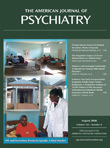To the Editor: Fear-associated freezing/immobilization is a well described, adaptive, defensive behavioral phenomenon that is common in many species of animals and occurs during conditions of natural threat or fear. Although freezing behavior has been assessed in humans utilizing stress/anxiety paradigms in the laboratory
(1), no study, to our knowledge, has explicitly examined the prevalence of freezing or immobilizing behaviors in a clinical sample.
In our study, we used the NIMH Panic Questionnaire
(2), a self-report instrument designed to elicit detailed, syndrome-specific information in patients with panic disorder, to obtain information regarding panic-related, freezing/immobilizing behavior. The frequency (“never,” “rarely,” “sometimes,” “always”) and severity (“mild,” “moderate,” “severe,” “extreme”) of 44 panic attack symptoms were obtained in a mixed treatment- and community-based sample of 1,118 people who met self-reported DSM criteria for panic disorder. In our analysis, we focused on a single item that determined whether the subjects were actually immobilized during a panic attack.
Among the participants, 198 (18%) reported “always” being immobilized during panic attacks. Fifty-three percent of the participants reported varying frequencies of immobilization panic (“sometimes” [N=405] and “rarely” [N=188]). Thus, 71% of the participants reported lifetime episodes of immobilization panic. Notably, subjects with positive lifetime histories of immobilization panic were 2.3 times (95% confidence interval [95% CI]=1.73–2.95, p<0.001) and 1.6 times (95% CI=1.21–2.09, p<0.001), respectively, more likely to suffer from disabling chronic anxiety and sleep panic attacks relative to panic disorder patients who had never experienced immobilization panic. Moreover, panic disorder patients who had experienced immobilization panic were 2.4 times (95% CI=1.64–3.57, p<0.001) more likely to also experience work impairment relative to panic disorder patients who did not report immobilization panic. This latter finding is noteworthy because work absenteeism is increased in panic disorder patients relative to nonpanic disorders in primary care settings.
Data presented in this report indicate that immobilizing/freezing behaviors are common, yet clinically underappreciated, events during panic attacks. The fact that patients with immobilization panic report a more severe course of illness underscores the importance of soliciting such data as part of standard clinical assessment.
Our laboratory, as well as that of others
(3), observes a phenomenological overlap and possible comorbid association between panic attacks and sleep paralysis, a rapid eye movement-related event characterized by muscle atonia and frightening immobilizations that can either emerge from or intrude upon sleep/wake states
(4) . Future studies are needed to determine the nature of freezing behaviors and related phenomena (e.g., muscle atonia/paralysis) in panic and other anxiety disorders during sleep/wake states.

